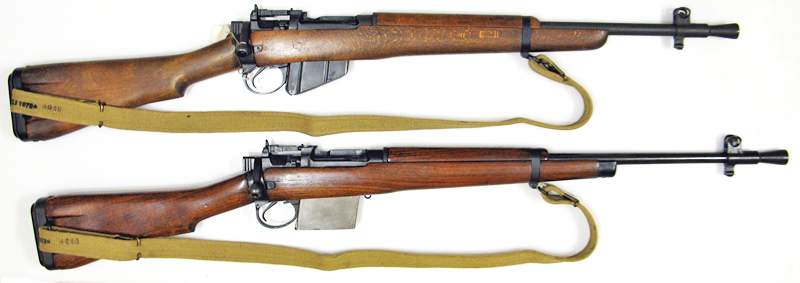The Australian Rifle No.6
In 1943, in the latter part of the Second World War (1939-1945), when much of the conflict was taking place in the Pacific theatre, Australia and India were nations allied to Great Britain and very much involved in the fighting in the confines of the jungle, and with the requirement to suitably arm parachute troops.
British forces had already been issued with the Lee-Enfield Rifle No.5, colloquially known as the "Jungle Carbine", a shortened and lightened version of the Lee-Enfield Rifle No.4.
In 1943 there was a perceived need for both India and Australia to have their own equivalents of the Rifle No.5, but neither country possessed tooling for the manufacture of the No.4 rifle, of which the No.5 was a conversion. Each of these Commonwealth countries had continued to use the Rifle, Short, Magazine Lee-Enfield (S.M.L.E. - colloquially known as the "Smellie") that had figured hugely during the First World War (1914-1918). Particularly in Australia during WW2, the S.M.L.E. had even been used as a sniper rifle in a similar configuration to that employed in WW1, but built at the Lithgow factory with an updated version of the Aldis telescopic sight.
Accordingly, the R.S.A.F. (Royal Small Arms Factory) at Enfield produced designs for a shortened and lightened rifle that could be converted from S.M.L.E. rifles to equated to the British No.5.
A small number of prototypes were built, leading to the production at Lithgow - the Australian small arms manufactory - of approximately two hundred trials rifles.
The prototype rifles were mainly produced in 1944 and the Australian trials rifles in 1945.
The first batch of these were the No.6 Mk.I rifles, initially with the original, but re-calibrated, S.M.L.E. tangent leaf rear-sight just moved rearwards on the shortened barrel. These rifles also used the original brass S.M.L.E. butt-plate; however, British trials of the No.5 had already shown the recoil of the lightened rifle to be very uncomfortable, and a steel cupped butt-plate with a rubber pad inserted had been designed and fitted to alleviate the heavy kick to the shoulder. It was not long before equivalent butt-plates were fitted to the No.6 trials rifles, and just a few of the first hundred No.6 Mk.I rifles and the majority of the second hundred are so configured.
The open iron sighting of the No.6 Mk.I rifles was considered outdated, as almost all Lee-Enfields manufactured from the introduction of the Lee-Enfield No.I Mark V were fitted with rear-mounted folding-leaf aperture sights. The No.5 carbine used a modified version of the No.4 rifle's sight, recalibrated to a maximum range of 800 yards, and an equivalent was designed for the second hundred trials rifles - afforded the nomenclature Rifle No.6 Mk.I/I - and the S.M.L.E. actions were modified to accommodate this.
The involved drawings and rifle photographs are replicated below on this page.
The cessation of hostilities in the Pacific arena, after the dropping of the atomic bombs on Hiroshima and Nagasaki in Japan, meant that any further development of these rifles was not fully justified, and the projects both in Australia and India were brought to a close. No.5 rifles continued to be used effectively in Europe, particularly by airborne troops during the June 1944 Operation Dynamo invasions and follow-on operations, but the proposed adoption of the "Jungle Carbine" as the main service rifle for British Forces fell foul of a shortcoming of the lightened carbine, the so called "wandering zero", brought about largely by the loss of rigidity caused by the machining of the No.4 action for weight reduction.
Whether this may also have contributed to the demise of S.M.L.E. conversions is pure conjecture, but these No.1 rifles were already anyway considered past their sell-by-date, and improved sub-machine guns were taking over in airborne and jungle activities where combat was more often than not at short range.
Below: Rifle No.6 Mk.I Serial No. XP 152
Drag horizontally to rotate subject - Click to zoom and drag to pan - Full screen viewing from expansion arrows.
Australian arms components produced at Lithgow are usually marked with their factory code "MA" for 'Munitions Australia'. Very often the code is stamped in conjunction with the date of manufacture,
What has yet to be mentioned, is that the bayonets for these trials rifles were specific to them. The bayonet lug was slightly different in design from that of the issue No.5 rifle, and whilst the flash-hider component may outwardly appear identical, it is not.
The bayonets are 'OA' stamped, with the code of the Rifle Factory No.3 at Orange, New South Wales. They carry the usual "X" bending mark and the 'Broad Arrow' acceptance stamp.
The wood grips are stamped "SLAZ 44", having been manufactured by the Slazenger company in 1944.
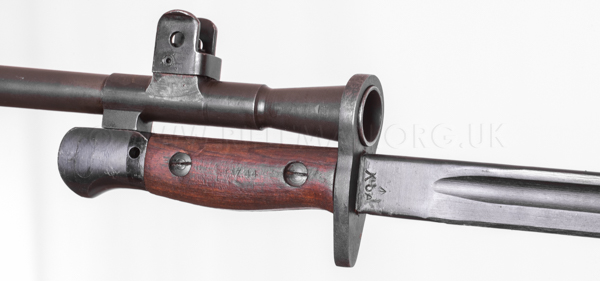
Below left: the No.5 Mk.I flash-hider and fore-sight.
Right: that of the No.6 Mk.I.
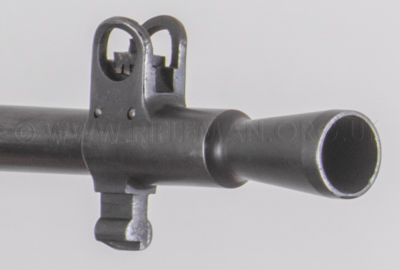 .........
......... 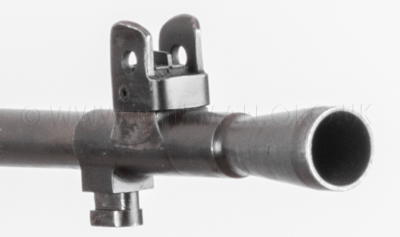
Thus the No.5 and No.6 rifles' bayonets are not interchangeable.
The Australian War Memorial museum collection, as well as a standard trials No.6 Mk.1 identical to the main rifle illustrated on this page, holds what appears to be a No.6 Mk.1 with the rubber padded No.5 buttplate as later fitted to the No.6 Mk.1/1, but is actually a specially moulded one-piece rubberised 'boot' that is hinged at the base and fits over the original brass SMLE butt-plate
The rifle also has the single 'Lee-Metford-like' fore-end finger grooves shown in the Enfield drawing no. DD(E) 3710, and is a prototype built prior to the production run of the trials rifles.
There are four images on this page that are copright to the AWM collection
Shown with their exhibit numbers, the first is AWM exhibit REL/16847

This early drawing no. DD(E) 3710 showed the No.6 rifle effectively to the design of the British issue No.5 rifle, with a steel fore-end nose-cap and standard No.5 butt-plate. However, the more unusual aspect is the flip-over battle sight mounted on the charger bridge of the SMLE action.
Click to Zoom
This arrangement was earlier to be seen on the Australian Shortened & Lightened trials rifle, illustrated below,
and on which page more detail is available.

A No.6 experimental rifle to this drawing is held in the National Firearms Collection
at the Royal Armouries as object no. PR. 5970.
A Lithgow SMLE based rifle to the early stocking pattern of AWM exhibit REL/16847 is held in the Royal Armouries as object no. PR.5972, however, it appears to be an intermediate example, as the rear-sight has been amended similarly to that of the AWM rifles REL/16295 and REL/19090 that are shown on this page shortly.
The rifle was built on a 1944 Lithgow SMLE No.1 Mk.III* action,
that was probably manufactured comparatively shortly before being built up.
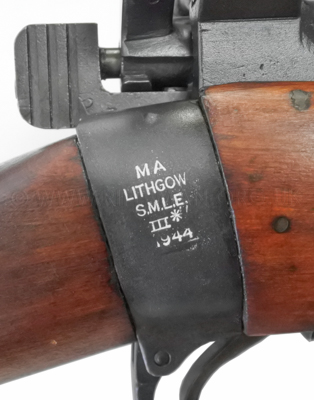
The rifle is shown below with its single fore-end hand groove, and the sight lowered.
It is most likely to be one of the prototypes for the Mk.1/1 rifle,
prior to the final production run of the trials rifles.


Below: the rear-sight leaf is ranged to the usual No.5 rifle's 100 to 800 yards.

And here shown raised to futher illustrate the modified elevation slide.

Next, the rifle with bolt open and sight raised.
It is just possible to discern the weld forward of the sight's fulchrum lug,
where the component has been attached to the rear top of the receiver body.

A close-up shot of the Australian hinged butt-plate arrangement.
The butt wood is only stamped with the number "3007" on the RHS,
although "No. V" is scratched into the wood on the LHS.
The rifle is otherwise unnumbered, and only proof marked.
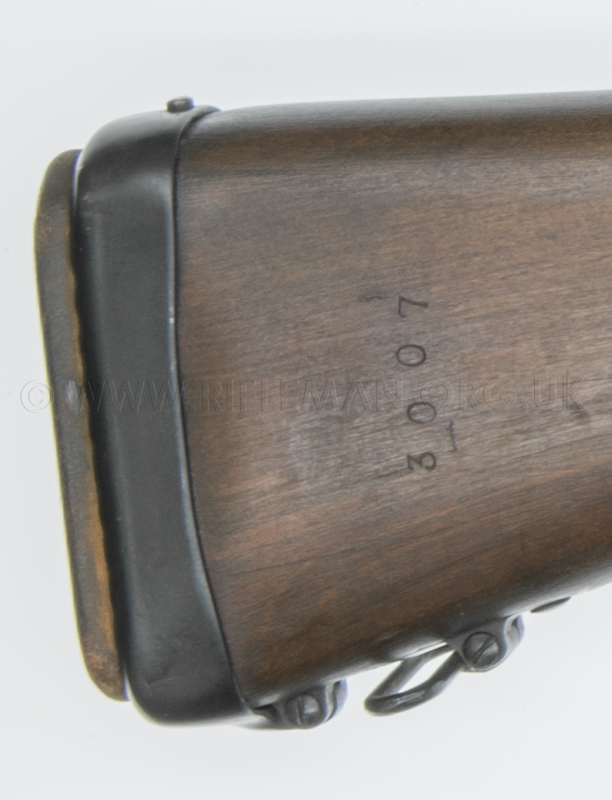
Images of another unnumbered rifle, with the finely-grooved fore-end and upper hand-guard
are shown on the Milsurps site. That rifle's receiver ring is stamped only with "XP"
when the rifle above has no mark whatsoever.
The Milsurps example is also fitted with a No.4 rifle-type rear-sight leaf with and elevation screw and knob,
when the rifle above has a No.1 Mk.V type leaf with only the slide for elevation,
as shown on the Enfield drawing no. DD(E) 3777 replicated a little further down this page.
Ian Skennerton, in his reference book "The Lee-Enfield", notes that trials assessing the various sighting options
decided that the sight mounted in the charger-loading bridge position, as on the Shortened and Lightened rifle,
afforded poor definition, the eye-relief being too great.
The barrel-mounted tangent leaf of the No.6 Mk.1 rifle 'gave good all-round performance,
but accuracy dropped away as the range increased and the light faded'.
The conclusion was that the aperture needed to be at the rear of the receiver, close to the firer's eye,
a situation that had already been decided upon at Enfield much earlier with the trials of the No.1 Mk.V rifle.
Of the near 200 trials rifles built, as already mentioned,
approximately half of the hundred of the earlier Mk.1 models used the original SMLE brass butt-plate,
and the remainder, up to rifle serial number XP198 used the rubber-padded butt-plate.
Similarly, the first half of the second hundred Mk.1/1 rifles retained the brass butt-plate,
and the remainder, to XP 296, the rubber-padded version.
The Mk.1/1 rifles are all believed to be configured with the No.4 rifle-type rear leaf sight,
which required modification of the rear of the receiver,
with lugs drilled for a machine screw on which the sight leaf pivotted
in the same way as the No.4 rifle.
The receiver was thus very similar to that for No.1 Mk.V rifle.
The brass butt-plated Mk.1/1 below is AWM exhibit REL/19090
 ,
,
The next rifle is configured largely to the Enfield drawing no. DD(E) 3777, shown below,
on which this modified sight was listed to be as drawing no. DD(E) 3777/4,
but the butt is again fitted with the bottom-hinged rubber-padded recoil-reducing steel butt-plate cap.
It is AWM exhibit REL/16295

This rifle is approximately configured to the drawing, apart from the plain-nosed fore-end, where the 1944 dated drawing shows a steel nose-cap; and the locally made rubber-padded butt plate, when the drawing shows the standard No.5 rifle's rubber pad within the steel butt-cap. The rear-sight is also to the drawing. The fore-end has the four fine grooves, and the upper handguard two matching, on either side - the unique Lithgow feature of their trials rifles.
Click to Zoom
A fourth No.6 rifle in the AWM collection has been converted to the NATO calibre of 7.62mm, with a Stirling type magazine.
It is AWM exhibit REL/19494

The rifle was built up on a 1942 SMLE action, and the magazine way and trigger-guard-casting aperture enlarged to accommodate the British X2 E1 20 experimental 7.62mm large capacity magazine. The barrel is slightly longer than that of the No.5 and trials No.6 rifles.
A similar rifle was also prototyped in the U.K., with the believed involvement of B.S.A., (the Birmingham Small Arms Company) in the construction of its special "in-the-white" magazine.
It is shown below beneath an issue No.5 rifle for comparison.
This is covered on our page for the Lee-Enfield Rifle No.5 in 7.62mm
The prime source for information on these rifles is
the series of reference books on the Lee-Enfield rifles authored by Ian Skennerton.
The latest edition is ISBN9780949749826
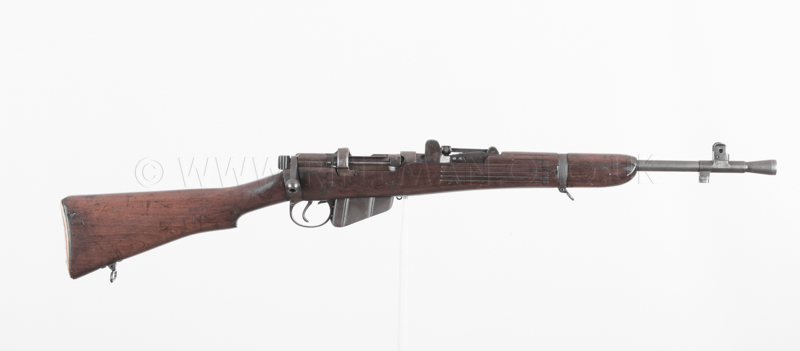
_3710-Edit.jpg)

